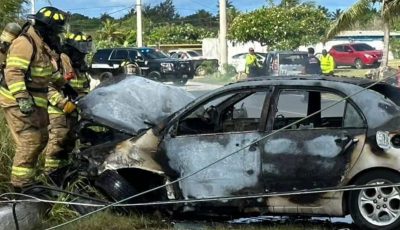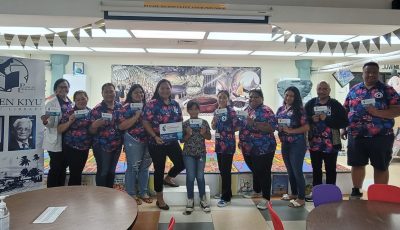Nurse turns Soudelor experience into book

Commonwealth Health Center staff nurse Riza Oledan-Ramos and Walt F.J. Goodrige hold up the former’s newest book Drinking Seawater: of storms and survival that documented her family’s harrowing experience during Typhoon Soudelor. (Jon Perez)
Riza Oledan-Ramos and her family were just spending their typical Sunday on the night of Aug. 2 last year. With their two kids, who were 14 and 4 at that time, already sleeping, they decided to just relax before starting another full week of work.
They knew then that there was an approaching typhoon—Soudelor—so they decided to stay at home and watch previous episodes of the hit series The Walking Dead.
“I even texted my manager at the hospital if we’re going to report to work the following day, because if it’s Typhoon Condition 1, we’re closed,” said Oledan-Ramos, who works as a staff nurse at the Commonwealth Health Center’s Dr. Jose T. Villagomez Center for Dialysis.
Like everyone else on Saipan, Oledan-Ramos and her husband Ding did not prepare since the previous typhoons were not that strong and caused no or little damage to the island.
Around quarter to 11pm, and in the middle of the show they’re watching, their walls started to vibrate as Soudelor’s strong winds—packing sustained winds of 130mph and as much as 180mph—pounded Saipan.
Water soon poured inside their home. “We didn’t notice that the roof of our home was blown away. It was dark and the rain kept on pouring. My husband told me ‘go get the kids and we’re leaving,’” said Oledan-Ramos.
They were living near San Jose Church and the entire area was already submerged in water. “It was like an ocean. We got into our car but we got stuck near Golden Harvest International School. All that time I kept on praying, ‘Lord keep us safe and Lord not now.’”
Her husband thought of going to Northern Marianas College since it is higher ground but they got out after their car got stuck and tried to look for cover. “It was really pitch dark, then I saw a flicker of light. We headed toward that direction. We’re wet and we’re running barefoot.”
They sought help from the residents of the first concrete house they saw. “My husband seemed to almost knock down the door. He was really banging hard and after two minutes the couple who lived there opened the door and let us in.”
It was these “Good Samaritans” that helped the Ramos family during their time of need. “They fed us, gave us dry clothes, and let us sleep in their house. I didn’t know their names and it was the following day that formal introductions were made.”
Experiencing one of the most devastating typhoons to hit Saipan, the Ramos family joined hundreds of other individuals on Saipan that experienced Soudelor’s fury that fateful day. It was this traumatic experience that Oledan-Ramos used as a driving force in writing Drinking Seawater: of storms and survival.
The book was a product of Walt F.J. Goodrige’s workshop. It was supposed to be a collaborative experience of all the participants but she already wrote 158 pages with her rough draft in just three weeks. It was then that Goodridge approached her with the idea of publishing what she wrote.
“Even me, I can’t believe that I finished writing the book in three weeks. I just sat in front of our computer and poured all my ideas and thoughts. Even after my 10-hour shift at work, and me still wearing scrubs.”
The book contained all of their experiences and struggles, during and after the typhoon. From the time they left their house, finding shelter, surviving the storm, and getting in line just to seek Food Stamps and aid from the CNMI Chapter of the American Red Cross to the Federal Emergency Management Agency.
Her father gave her the idea for the title after she told him, during one of their telephone conversations after the storm, that U.S. Marines have been turning seawater to drinking water. “My father told me, ‘that’s amazing. You’re drinking seawater. I didn’t know the Marines could do that.’”
Oledan-Ramos grew up in Biliran, Samar in Eastern Visayas in the Philippines that has also its own share of strong typhoons. She arrived on Saipan in 2006. Drinking Seawater is available at Bestseller and Amazon.



























